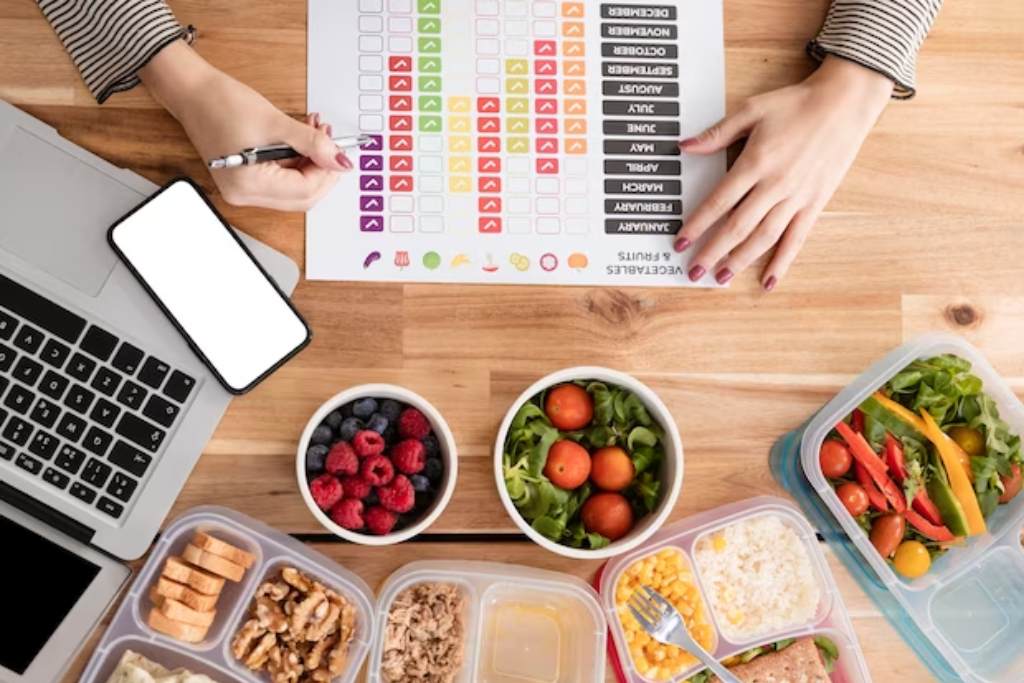Welcome to the ultimate guide on how to eat healthy without breaking the bank! We all know that maintaining a nutritious diet is crucial for our overall well-being. But let’s face it, eating healthy can sometimes be expensive. The good news is that with a little planning and some savvy shopping skills, you can enjoy delicious and nourishing meals while staying within your budget. In this blog post, we will debunk common misconceptions about eating healthy on a budget, provide practical tips for meal planning and grocery shopping on a tight purse string, share wallet-friendly recipes that won’t compromise taste or nutrition, reveal secrets to saving money on organic and specialty foods, as well as explore other creative ways to trim your food expenses. So get ready to revolutionize your approach to eating healthily because being mindful of both our bodies and wallets has never been easier!
The Importance of Eating Healthy
Our bodies are incredible machines that require proper fuel to function at their best. Eating healthy plays a vital role in nourishing our bodies and providing the necessary nutrients for growth, development, and overall well-being.
A balanced diet filled with fruits, vegetables, whole grains, lean proteins, and healthy fats can help reduce the risk of chronic diseases like heart disease, diabetes, and certain types of cancer. It can also boost our immune system and improve our energy levels.

In addition to physical health benefits, eating nutritious foods can have a positive impact on our mental well-being too. Research suggests that incorporating nutrient-rich foods into our diets can help improve mood stability and cognitive function.
Healthy eating is not just about what we put into our bodies; it’s also about what we don’t consume excessively. By reducing processed foods high in added sugars and unhealthy fats from our diets, we can lower the risk of obesity-related conditions such as high blood pressure and cholesterol.
Making conscious choices when it comes to food empowers us to take control of our health. It allows us to prioritize self-care by nourishing ourselves from within, resulting in increased vitality and an improved quality of life.
So, let’s embrace the importance of eating healthy! Not only will it benefit us physically and mentally, but it will also set a positive example for those around us. Remember that small changes over time can lead to long-lasting habits that promote wellness—all while being mindful of your budget!
Common Misconceptions about Eating Healthy on a Budget
Eating healthy is often seen as an expensive endeavor, but the truth is that it doesn’t have to be. There are several common misconceptions when it comes to eating healthy on a budget and debunking these myths can help you make nutritious choices while still saving money.
One misconception is that healthy food is always more expensive than unhealthy options. While it’s true that some organic or specialty foods can come with a higher price tag, there are plenty of affordable options available. Fresh fruits and vegetables can be found at reasonable prices, especially if you shop in-season or buy from local farmers’ markets.

Another myth is that cooking from scratch takes too much time and effort. Preparing meals at home indeed requires some planning and preparation, but there are ways to simplify the process. Meal prepping can save you time during busy weekdays, as you can cook larger batches of meals and freeze leftovers for later use.
Some people also believe that healthy eating means cutting out all indulgences or treats. However, enjoying small portions of your favorite snacks or desserts in moderation can still fit into a balanced diet without breaking the bank.
Many assume that buying in bulk automatically leads to savings. While bulk shopping can be cost-effective for non-perishable staples like rice or beans, it’s important to consider portion sizes and potential waste before stocking up on perishable items.
By dispelling these misconceptions about eating healthy on a budget, we hope to inspire others to prioritize their well-being without feeling overwhelmed by financial constraints. Remember: with proper planning and smart shopping strategies, anyone can maintain a nutritious diet without sacrificing their bank account!
Tips for Meal Planning and Grocery Shopping on a Budget
Meal planning and grocery shopping on a budget may seem like daunting tasks, but with some simple tips and tricks, it can become much easier. The key is to be organized and strategic in your approach.
Take some time to plan your meals for the week ahead. Look at what ingredients you already have on hand and create meals around those items. This will help you avoid unnecessary purchases at the grocery store.

Make a list before heading to the store and stick to it! This will prevent impulse buys that can quickly add up. Try to shop at discount stores or farmers’ markets, where prices are often lower than in traditional supermarkets.
Buying in bulk can also save you money eventually. Look for items such as rice, beans, pasta, and canned goods that have a long shelf life and buy them in larger quantities when they are on sale.
Consider purchasing generic brands instead of name brands. Often, there is little difference in quality but significant savings when choosing generic options.
Don’t forget about frozen fruits and vegetables! They are just as nutritious as fresh produce but often more affordable. Plus, they have a longer shelf life, which means less waste!
Embrace leftovers! Rather than throwing out excess food from meals, repurpose them into new dishes or freeze them for later use.
By following these tips for meal planning and grocery shopping on a budget, you can eat healthy without breaking the bank!
Budget-Friendly Healthy Recipes
Eating healthy doesn’t have to break the bank. With some creativity and planning, you can whip up delicious and nutritious meals without blowing your budget. Here are a few budget-friendly, healthy recipes that will satisfy your taste buds and keep your wallet happy.
- Veggie-packed stir-fry: Stir-fries are not only quick and easy to make, but they’re also a great way to use up any leftover vegetables in your fridge. Simply sauté a mix of colorful veggies like bell peppers, broccoli, carrots, and snap peas in some olive oil or low-sodium soy sauce. Serve it over brown rice or whole wheat noodles for a satisfying meal.
- Quinoa salad with roasted vegetables: Quinoa is an affordable grain that’s packed with protein and fiber. Toss cooked quinoa with roasted vegetables like zucchini, tomatoes, onions, and bell peppers for a flavorful salad. Drizzle it with lemon juice and olive oil dressing for added zest.
- Lentil soup: Lentils are not only cheap but also rich in protein and iron. Cook up a hearty lentil soup by simmering lentils with diced tomatoes, carrots, celery, onion, garlic powder, cumin, and paprika
How to Save Money on Organic and Specialty Foods
When it comes to eating healthy, many people believe that organic and specialty foods are out of their budget. However, with a little bit of planning and creativity, it is possible to enjoy these nutritious options without breaking the bank.
One way to save money on organic and specialty foods is by buying them in bulk. Many stores offer discounts when you purchase larger quantities of items. This can be especially beneficial for staples like grains, nuts, and dried fruits that have a longer shelf life.

Another cost-saving tip is to compare prices at different stores or online platforms. Don’t be afraid to shop around and look for deals. You may find that certain items are more affordable at one store compared to another.
Consider joining a co-op or community-supported agriculture (CSA) program. These programs often provide access to locally grown organic produce at lower prices than traditional grocery stores. Plus, you’ll be supporting local farmers in your community!
If you’re willing to put in some time and effort, growing your food can also help save money on organics. Even if you don’t have much space, herbs like basil or mint can easily be grown indoors or in small pots on a balcony.
Don’t underestimate the power of meal planning when it comes to saving money on specialty foods. By knowing exactly what ingredients you need for each meal, you can avoid impulse purchases and reduce waste.
Eating healthy doesn’t have to mean spending a fortune on organic and specialty foods. With smart shopping strategies like buying in bulk, comparing prices, joining co-ops or CSAs, and even growing your food, there are plenty of ways to enjoy these nutritious options while sticking within your budget!
Other Ways to Save Money on Eating Healthy
In addition to meal planning, grocery shopping strategies, and budget-friendly recipes, there are some other ways you can save money while eating healthy. Here are a few tips to help you stretch your dollar even further:
- Buy in bulk: Purchasing items like grains, beans, nuts, and seeds in bulk can be much cheaper than buying pre-packaged options. Buying larger quantities reduces packaging costs and allows you to portion out what you need for each meal.
- Utilize frozen fruits and vegetables: Frozen produce is often more affordable than fresh options and can be just as nutritious. Plus, they have a longer shelf life, which means less food waste.
- Grow your herbs and vegetables: If you have the space or access to a community garden, consider growing your herbs and vegetables. Not only will this save money but it also gives you the satisfaction of nurturing plants from seedlings to harvest.
- Shop local farmers’ markets or join a CSA: Local farmer’s markets often offer fresh produce at competitive prices compared to supermarkets. Joining a Community Supported Agriculture (CSA) program is another great way to support local farmers while getting affordable seasonal produce delivered right to your doorstep.
- Reduce meat consumption: Meat can be one of the most expensive items on your grocery list. Consider incorporating more plant-based proteins like beans, lentils, tofu, or tempeh into your meals instead of relying solely on animal protein sources.
6. Thrift stores for kitchenware: Instead of splurging on fancy kitchen gadgets or cookware that may break the bank, check out thrift stores, where you might find hidden gems at bargain prices!
Remember that eating healthy doesn’t always mean breaking the bank! With these tips and tricks up your sleeve, you can nourish yourself with wholesome foods without sacrificing your budget!
Check out “The Incredible Benefits of Saying Goodbye to Refined Oil” to discover how eliminating refined oils from your diet can lead to numerous health advantages, including improved heart health, enhanced metabolism, and better overall well-being.






